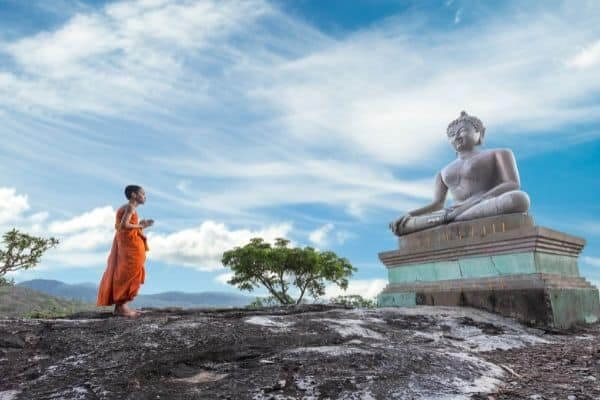Most people associate the idea of Nirvana with Gautama Buddha. And that is rightly so, because he made Nirvana (or Nibanna, as he termed it) the central concept of Buddhism. However, it may come as a surprise that the term Nirvana appears in the Bhagwad Gita. In its very second chapter (Sankhya-Yog or The Book of Doctrines), mention is made of brahma nirvanam. The Bhagwad Gita further elaborates on this concept in its fifth chapter which is called Karmasanyasayog or The Book of Religion by Renouncing The Fruit of Works.
Buddhist and Hindu terminology can be expected to be often identical because the original teachings of the Buddha are patently Indian. There is no doubt that several versions of that religion have later developed in East and Southeast Asia. However, the core meditative practices have remained intact along with the ultimate goal of Nirvana. For example, the elevated meditative state of dhyana, which forms part of Patanjali’s eightfold path, became chan in China and zen in Japan.
Indeed, Hinduism and Buddhism converge in their meditative yogic practices. The Bhagwad Gita, Patanjali’s Yoga Sutras and the Dhammapada belong to same Indian philosophical crucible, more particularly the Samkhya school of philosophy. Chapter five of the Bhagwad Gita states: “That man sees with clear sight who sees that the Sankhya and the Yoga doctrines are identical.” (Judge’s translation). Buddhism has yoga at its core, particularly the yoga of the mind. Patanjali’s state of dhyana finds its way into Buddhist terminology wherein beings who have attained a very high level of meditation are known as Dhyani Buddhas.

With regard to Brahma Nirvanam, Brahma represents the Absolute and Telang translates nirvanam as bliss. His translation reads: “The devotee whose happiness is within himself, whose recreation is within himself and whose recreation is within himself, and whose light of knowledge is within himself becomes one with Brahman [and he] obtains the Brahmic bliss”. This bliss is obviously similar to the anand of the sat-chit-anand trilogy of Sankaracharya. It resembles the ecstasy experienced by saints in both the Eastern and Western traditions.
There are assuredly practical aspects to this meditative state and the joy that it can create. If deep meditation results in “bliss of the Absolute”, might not this form of meditation be used as a cure for depression? In fact, Buddhist monks have been using meditation as a method for curing drug addiction in the temples of Thailand.
It is also well known that in Japan business executives suffering from burnout are often sent to Zen monasteries so as to recuperate. Two methods of meditation have been developed in the USA, one by Carl Simonton and another by Stephanie Siminton-Atchelet, for treating cancer patients. They use imagery and visualisation and claim some degree of success.
Another method of meditation for cancer patients, developed by Ainslie Meares in Australian, has also been reported as being effectual. It is said that the goal of meditation is to raise awareness so that one can get the mind back under control for the purposes of self-healing and self-regulation.
India’s meditation systems require considerable attitudinal preparation. Patanjali outlined the things to do and the things to avoid (yamas and niyamas). The Bhagwad Gita similarly speaks about the qualities (gunas) to be encouraged and those to be avoided. The Buddha in the Dhammapada gave lengthy elaborations on character building. Like the Bhagwad Gita, it pointed out that a Brahmin is not one born as such but is one who develops an exemplary character.

READ ALSO: Dealing with loss in the family: How meditation can help
The final chapter of the Dhammapada (The Brahmana) is a lengthy treatise on who is a Brahmin: “He who is thoughtful, blameless, settled, dutiful, without passions, and who has attained the highest end, him I call indeed a Brahmana……Him I call indeed a Brahmana who does not offend by body, word, or thought, and is controlled on these three points” (Muller’s version). The Buddha went as far as to say that “the Awakened call patience, the highest penance [and] long-suffering the highest Nirvana” (Dammapada, chapter 14, Muller).
All meditative systems have union with the Absolute as the ultimate goal. India’s meditative systems spelt this out very clearly and that is why they are so popular around the world today. A picturesque Buddhist symbolism sees the subsuming of the individual soul into the Universal Soul: “The Dewdrop slips into the Shining Sea!” (Arnold’s Light of Asia). Very similarly, the Persian Sufi poet Rumi wrote: “Immersion in the glory of the Lord of glory! … As it were identification with the Very Ocean!” (Rumi, Masnavi, Whinefield). Perhaps we can envisage Nirvanam as complete meditative absorption in the Divine.
References:
B. G. Telang’s, Sir Edwin Arnold’s and Q. Judges translations of the Bhagwad Gita.
Max Muller’s translation of the Dhammapada and Arnold’s Light of Asia (on the Buddha) are nineteenth century works which brought these classics to the attention of the world.
Simonton’s and Atcchelet’s meditation for cancer patients is described in Unconventional Cancer Treatments, 1990 (Congress of the USA, Office of Technological Assessment).
READ ALSO: Saraswati symbolism
Link up with us!
Indian Link News website: Save our website as a bookmark
Indian Link E-Newsletter: Subscribe to our weekly e-newsletter
Indian Link Newspaper: Click here to read our e-paper
Indian Link app: Download our app from Apple’s App Store or Google Play and subscribe to the alerts
Facebook: facebook.com/IndianLinkAustralia
Twitter: @indian_link
Instagram: @indianlink
LinkedIn: linkedin.com/IndianLinkMediaGroup





